VERTICAL CROSS SECTIONS
by ZAMG
Cross sections are a very valuable tool. Parameters which are of special interest for such a presentation are potential temperature and equivalent potential temperature as well as humidity, which together can be used, for instance, for stability or instability computations. However, parameters discussed earlier such as temperature advection, vorticity and vorticity advection, divergence and vertical motion can reveal interesting processes in the vertical. Most of the parameters can be computed from numerical model output, some of them such as stability or Richardson number need the higher vertical resolution of radiosonde data.
Equivalent potential temperature is especially useful for revealing frontal zones. They consist of zones of high gradients inclined downward from high levels, for instance 300 hPa to the ground (in the case of a surface front). Cold and Warm Fronts as well as Occlusions and conditionally unstable areas can also be differentiated in this way.
The following examples from the demonstration case study are a selection of parameters showing some typical features of a cross section through the Cold Front in Central Europe (satellite image with superimposed cross section line below).
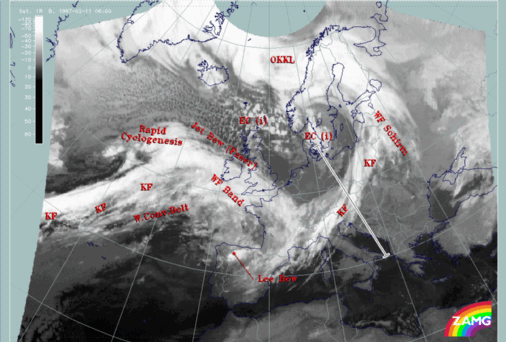
|
11 February 1997/06.00 UTC - Vertical cross section; black: isentropes (ThetaE), red thin: temperature advection - CA, red thick:
temperature advection - WA, orange thin: IR pixel values, orange thick: WV pixel values
|
11 February 1997/06.00 UTC - Vertical cross section; black: isentropes (ThetaE), blue: relative humididty, orange thin: IR pixel
values, orange thick: WV pixel values
|
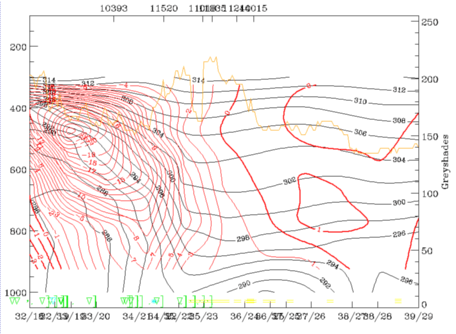
|
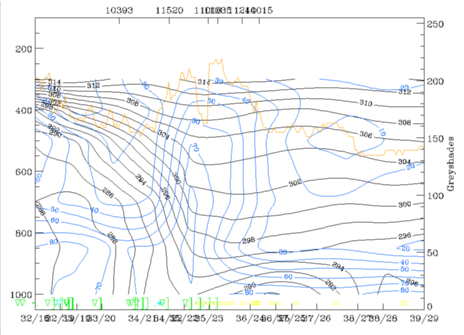
|
Although the maximum of cold advection (CA; thin red lines in the left figure) appears within the crowding zone and closer to its lower boundary, the whole frontal surface is, in fact, associated with CA. CA can also be found in front of the frontal zone which, in classical cases, should be an area of maximal warm advection (WA). WA (thick red lines) can, in fact, be found only south of the station Graz (11240).
The humidity field (right image top, blue lines) shows a high humidity zone which is forward inclined from the station Prague (11520, between grid points 34/21 and 35/22) close to the ground up to about 400 hPa south of Vienna (11035, between grid points 35/23 and 36/24). This is typical of a Kata Cold Front with cloudiness and precipitation in front of the frontline. The weather symbols on the base line below 1000 hPa show some slight actual rain falling near to grid point 35/23 which, when compared to the humidity field (right image), is associated with a very humid layer between 800 and 650 hPa on top of the frontal surface. In the cold air below the frontal surface a lot of showers appear.
The orange line in the above cross section represents the IR pixel values. The highest values representing the cloudiness of the Cold Front can be found between the station Prague (11520) and the grid point 36/24 which corresponds to the zone of high humidity.
|
11 February 1997/06.00 UTC - Vertical cross section; black: isentropes (ThetaE), cyan thick: vertical motion (omega) - upward
motion, cyan thin: vertical motion (omega) - downward motion, orange thin: IR pixel values, orange thick: WV pixel values
|
11 February 1997/06.00 UTC - Vertical cross section; black: isentropes (ThetaE), magenta thin: divergence, magenta thick:
convergence, orange thin: IR pixel values, orange thick: WV pixel values
|
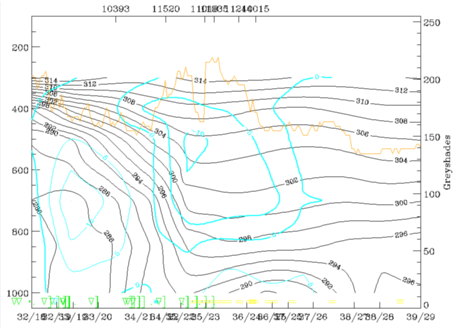
|
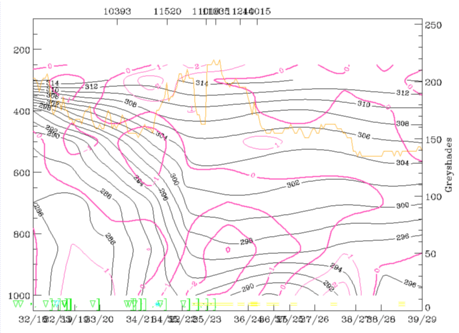
|
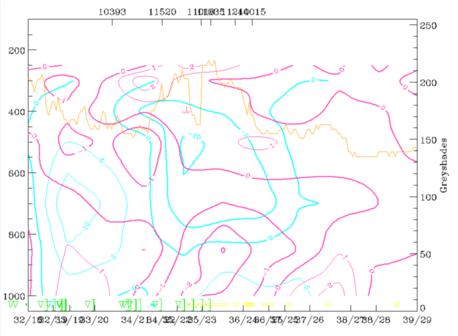
|
|
|
11 February 1997/06.00 UTC - Vertical cross section; black: isentropes (ThetaE), magenta thin: divergence, magenta thick:
convergence, cyan thick: vertical motion (omega) - upward motion, cyan thin: vertical motion (omega) - downward motion, orange
thin: IR pixel values, orange thick: WV pixel values
|
- The existence of cloudiness in front of the surface frontline especially in the case of a Kata Cold Front;
- The upgliding of warmer air on top of the frontal surface and the sinking of the cold air below the frontal surface.
It is also very interesting to note the relevant contributions to upward motion as already discussed in the case of isobaric surfaces in the previous chapter. The left figure bottom shows the combination of divergence and omega. The thick magenta lines represent convergence and there is a backward inclined zone from the surface with a maximum between grid points 35/23 and 36/24 up to 400 - 300 hPa with another maximum between the stations Prague (11520) and Lindenberg (10393). This zone of convergence coincides with the frontal zone represented in the isentropes and reveals the basic frontal conditions. The zone of upward motion on top of the convergence zone supports the basic idea of a circulation cell described in chapter Divergence .
These have been a few selected examples to show the potential use of vertical cross sections; in the manual the typical structure of the relevant parameters in vertical cross sections is described for every conceptual model. In the case studies vertical cross sections are also widely used.

